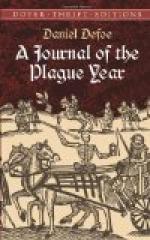Fourth, Besides this, there was a piece of ground in Moorfields, by the going into the street which is now called Old Bethlem, which was enlarged much, though not wholly taken in, on the same occasion.
N.B. The author of this journal lies buried in that very ground, being at his own desire, his sister having been buried there a few years before.
Fifth, Stepney Parish, extending itself from the east part of London to the north, even to the very edge of Shoreditch churchyard, had a piece of ground taken in to bury their dead, close to the said churchyard; and which, for that very reason, was left open, and is since, I suppose, taken into the same churchyard. And they had also two other burying places in Spittlefields,—one where since a chapel or tabernacle has been built for ease to this great parish, and another in Petticoat Lane.
There were no less than five other grounds made use of for the parish of Stepney at that time; one where now stands the parish church of St. Paul, Shadwell, and the other where now stands the parish church of St. John, at Wapping, both which had not the names of parishes at that time, but were belonging to Stepney Parish.
I could name many more; but these coming within my particular knowledge, the circumstance, I thought, made it of use to record them. From the whole, it may be observed that they were obliged in this time of distress to take in new burying grounds in most of the outparishes for laying the prodigious numbers of people which died in so short a space of time; but why care was not taken to keep those places separate from ordinary uses, that so the bodies might rest undisturbed, that I cannot answer for, and must confess I think it was wrong. Who were to blame, I know not.
I should have mentioned that the Quakers[324] had at that time also a burying ground set apart to their use, and which they still make use of; and they had also a particular dead cart to fetch their dead from their houses. And the famous Solomon Eagle, who, as I mentioned before,[325] had predicted the plague as a judgment, and run naked through the streets, telling the people that it was come upon them to punish them for their sins, had his own wife died[326] the very next day of the plague, and was carried, one of the first, in the Quakers’ dead cart to their new burying ground.




